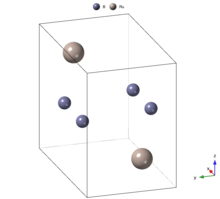Boride
A boride is a compound between boron and a less electronegative element, for example silicon boride (SiB3 and SiB6). The borides are a very large group of compounds that are generally high melting and are covalent more than ionic in nature. Some borides exhibit very useful physical properties. The term boride is also loosely applied to compounds such as B12As2 (N.B. Arsenic has an electronegativity higher than boron) that is often referred to as icosahedral boride.
Ranges of compounds
The borides can be classified loosely as boron rich or metal rich, for example the compound YB66 at one extreme through to Nd2Fe14B at the other. The generally accepted definition is that if the ratio of boron atoms to metal atoms is 4:1 or more, the compound is boron rich; if it is less, then it is metal rich.
Boron rich borides (B:M 4:1 or more)
The main group metals, lanthanides and actinides form a wide variety of boron-rich borides, with metal:boron ratios up to YB66.
The properties of this group vary from one compound to the next, and include examples of compounds that are semi conductors, superconductors, diamagnetic, paramagnetic, ferromagnetic or anti-ferromagnetic.[1] They are mostly stable and refractory.
Some metallic dodecaborides contain boron icosahedra, others (for example yttrium, zirconium and uranium) have the boron atoms arranged in cuboctahedra.[2]
LaB6 is an inert refractory compound, used in hot cathodes because of its low work function which gives it a high rate of thermionic emission of electrons; YB66 crystals, grown by an indirect-heating floating zone method, are used as monochromators for low-energy synchrotron X-rays.[3] VB2 has shown some promise as potential material with higher energy capacity than lithium for batteries.[4]
Metal rich borides (B:M less than 4:1)
The transition metals tend to form metal rich borides. Metal-rich borides, as a group, are inert and have high melting temperature. Some are easily formed and this explains their use in making turbine blades, rocket nozzles, etc. Some examples include AlB2 and TiB2. Recent investigations into this class of borides have revealed a wealth of interesting properties such as super conductivity at 39 K in MgB2 and the ultra-incompressibility of OsB2 and ReB2.[5]
Boride structures
The boron rich borides contain 3-dimensional frameworks of boron atoms that can include boron polyhedra. The metal rich borides contain single boron atoms, B2 units, boron chains or boron sheets/layers.
Examples of the different types of borides are:
- isolated boron atoms, example Mn4B
- B2 units, example V3B
- chains of boron atoms, example FeB
- sheets or layers of boron atoms CrB2
- 3-dimensional boron frameworks that include boron polyhedra, example NaB15 with boron icosahedra
| Formula | CAS registry number | density (g/cm3)[6] | melting point (°C) | electrical resistivity (10−8Ω·m) | Knoop hardness (0.1 kp load) |
|---|---|---|---|---|---|
| TiB2 | 12045-63-5 | 4.38 | 3225 | 9–15 | 2600 |
| ZrB2 | 12045-64-6 | 6.17 | 3050 | 7–10 | 1830 |
| HfB2 | 12007-23-7 | 11.2 | 3250 | 10–12 | 2160 |
| VB2 | 12007-37-3 | 5.10 | 2450 | 16–38 | 2110 |
| NbB | 12045-19-1 | 7.5 | 2270 | - | - |
| NbB2 | 12007-29-3 | 6.97 | 3050 | 12–65 | 2130 |
| TaB | 12007-07-7 | 14.2 | 2040 | - | - |
| TaB2 | 12007-35-1 | 11.2 | 3100 | 14–68 | 2500 |
| CrB2 | 12007-16-8 | 5.20 | 2170 | 21–56 | 1100 |
| Mo2B5 | 12007-97-5 | 7.48 | 2370 | 18–45 | 2180 |
| W2B5 | 12007-98-6 | 14.8 | 2370 | 21–56 | 2500 |
| Fe2B | 12006-85-8 | 7.3 | 1389 | - | 1800 |
| FeB | 12006-84-7 | 7 | 1658 | 30 | 1900 |
| CoB | 12006-77-8 | 7.25 | 1460 | 26 | 2350 |
| Co2B | 12045-01-1 | 8.1 | 1280 | - | - |
| NiB | 12007-00-0 | 7.13 | 1034 | 23 | - |
| Ni2B | 12007-01-1 | 7.90 | 1125 | - | - |
| LaB6 | 12008-21-8 | 6.15 | 2715 | 15 | 2010 |
| UB4 | 12007-84-0 | 9.32 | 2530 | 30 | 1850 |
| UB2 | 12007-36-2 | 12.7 | 2430 | - | - |

See also
- Crystal structure of boron-rich metal borides
- Iron tetraboride
- Yttrium borides - a representative class of metal borides
- Magnesium diboride - a superconductor
References
- ^ Lundstrom T (1985). "Structure, defects and properties of some refractory borides". Pure Appl. Chem. (free download pdf). 57 (10): 1383. doi:10.1351/pac198557101383.
- ^ VI Matkovich; J Economy; R F Giese Jr; R Barrett (1965). "The structure of metallic dodecaborides" (PDF). Acta Crystallographica. 19 (6): 1056–1058. Bibcode:1965AcCry..19.1056M. doi:10.1107/S0365110X65004954. Archived from the original (PDF) on 2014-12-22. Retrieved 2008-08-28.
- ^ Wong, Jo; T Tanaka; M Rowen; F Schäfer; B R Müller; Z U Rek (1999). "YB66 – a new soft X-ray monochromator for synchrotron radiation. II. Characterization". Journal of Synchrotron Radiation. 6 (6): 1086–1095. Bibcode:1999JSynR...6.1086W. doi:10.1107/S0909049599009000.
- ^ "High Energy Density VB2/Air Batteries for Long Endurance UAVs | SBIR.gov". www.sbir.gov. Retrieved 2024-02-08.
- ^ Chen, Hui; Zou, Xiaoxin (2020). "Intermetallic borides: structures, synthesis and applications in electrocatalysis". Inorganic Chemistry Frontiers. 7 (11): 2248–2264. doi:10.1039/D0QI00146E. ISSN 2052-1553. S2CID 216259662.
- ^ Haynes, William M. (2010). Handbook of Chemistry and Physics (91 ed.). Boca Raton, Florida, USA: CRC Press. ISBN 978-1-43982077-3.
Books
- Greenwood, Norman N.; Earnshaw, Alan (1997). Chemistry of the Elements (2nd ed.). Butterworth-Heinemann. ISBN 978-0-08-037941-8.
- Cotton, F. Albert; Wilkinson, Geoffrey; Murillo, Carlos A.; Bochmann, Manfred (1999), Advanced Inorganic Chemistry (6th ed.), New York: Wiley-Interscience, ISBN 0-471-19957-5
